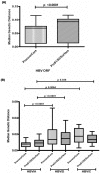Molecular characterization of HBV strains circulating among the treatment-naive HIV/HBV co-infected patients of eastern India
- PMID: 24587360
- PMCID: PMC3938687
- DOI: 10.1371/journal.pone.0090432
Molecular characterization of HBV strains circulating among the treatment-naive HIV/HBV co-infected patients of eastern India
Abstract
Previously we reported that the exposure to hepatitis B virus (HBV) infection serves as a major threat among the treatment naive HIV infected population of eastern India. Hence, molecular characterization of these strains is of utmost importance in order to identify clinically significant HBV mutations. A total of 85 treatment naive HIV/HBV co-infected participants were included of whom the complete basal core promoter/precore region, the core and the whole envelope gene could be successfully sequenced for 59, 57 and 39 isolates respectively. Following phylogenetic analysis, it was found that HBV/D was the predominant genotype with HBV/D2 (38.5%) being the most prevalent subgenotype followed by HBV/A1. The major mutations affecting HBeAg expression includes the A1762T/G1764A (13.6%), G1896A (22%) and G1862T mutation (33.9%) which was predominantly associated with HBV/A1. Moreover, the prevalence of G1896A was considerably high among the HBeAg negative HIV/HBV co-infected subjects compared to HBV mono-infection. The main amino acid substitutions within the MHC class II restricted T-cell epitope of HBcAg includes the T12S (15.8%) and T67N (12.3%) mutation and the V27I (10.5%) mutation in the MHC class I restricted T-cell epitope. PreS1/S2 deletion was detected in 3 isolates with all harboring the BCP double mutation. Furthermore, the frequently occurring mutations in the major hydrophilic loop of the S gene include the T125M, A128V and M133I/L. Therefore, this study is the first from India to report useful information on the molecular heterogeneity of the HBV strains circulating among the treatment naive HIV/HBV co-infected population and is thus clinically relevant.
Conflict of interest statement
Figures




Similar articles
-
Genotyping and molecular characterization of hepatitis B virus from human immunodeficiency virus-infected individuals in southern Africa.PLoS One. 2012;7(9):e46345. doi: 10.1371/journal.pone.0046345. Epub 2012 Sep 28. PLoS One. 2012. PMID: 23029487 Free PMC article.
-
Complete genome sequence and phylogenetic analysis of hepatitis B virus isolated from Turkish patients with chronic HBV infection.J Med Virol. 2005 Aug;76(4):476-81. doi: 10.1002/jmv.20386. J Med Virol. 2005. PMID: 15977237
-
Hepatitis B virus genotypes and mutations in the basal core promoter and pre-core/core in chronically infected patients in southern Brazil: a cross-sectional study of HBV genotypes and mutations in chronic carriers.Rev Soc Bras Med Trop. 2014 Nov-Dec;47(6):701-8. doi: 10.1590/0037-8682-0158-2014. Rev Soc Bras Med Trop. 2014. PMID: 25626648
-
Variability of the preC/C region of hepatitis B virus genotype A from a South African cohort predominantly infected with HIV.J Med Virol. 2013 Nov;85(11):1883-92. doi: 10.1002/jmv.23695. Epub 2013 Aug 7. J Med Virol. 2013. PMID: 23925707 Free PMC article.
-
The host immune response may be responsible for selection of envelope and precore/core variants of HBV.J Hepatol. 1991;13 Suppl 4:S108-13. doi: 10.1016/0168-8278(91)90038-d. J Hepatol. 1991. PMID: 1822501 Review. No abstract available.
Cited by
-
Precore/core region mutations of hepatitis B virus related to clinical severity.World J Gastroenterol. 2016 May 7;22(17):4287-96. doi: 10.3748/wjg.v22.i17.4287. World J Gastroenterol. 2016. PMID: 27158197 Free PMC article. Review.
-
Parenteral viral hepatitis among students in Da Nang, Vietnam, and insights into new hepatitis B virus genotype B classification.Sci Rep. 2025 Jul 1;15(1):21589. doi: 10.1038/s41598-025-05409-y. Sci Rep. 2025. PMID: 40594411 Free PMC article.
-
A Recent Prevalence of Hepatitis B Virus (HBV) Genotypes and Subtypes in Asia: A Systematic Review and Meta-Analysis.Healthcare (Basel). 2023 Apr 1;11(7):1011. doi: 10.3390/healthcare11071011. Healthcare (Basel). 2023. PMID: 37046937 Free PMC article. Review.
-
Molecular analysis of HBV pre-core gene mutations in patients co-infected with HIV at a tertiary care hospital in North India.Access Microbiol. 2025 Aug 5;7(8):000927.v4. doi: 10.1099/acmi.0.000927.v4. eCollection 2025. Access Microbiol. 2025. PMID: 40771828 Free PMC article.
-
Review on hepatitis B virus precore/core promoter mutations and their correlation with genotypes and liver disease severity.World J Hepatol. 2022 Apr 27;14(4):708-718. doi: 10.4254/wjh.v14.i4.708. World J Hepatol. 2022. PMID: 35646275 Free PMC article. Review.
References
-
- Soriano V, Barreiro P, Martin-Carbonero L, Castellares C, Ruiz-Sancho A, et al. (2007) Treatment of Chronic Hepatitis B or C in HIV-Infected Patients with Dual Viral Hepatitis. J Infect Dis 195(8): 1181–1183. - PubMed
-
- Sellier P, Schnepf N, Jarrin I, Mazeron MC, Simoneau G, et al. (2010) Description of liver disease in a cohort of HIV/HBV coinfected patients. J Clin Virol 47(1): 13–17. - PubMed
-
- Mathews G, Bhagani S (2003) The epidemiology and natural history of HIV/HBV and HCV co-infections. J HIV Ther 8(4): 77–84. - PubMed
-
- Thio CL, Seaberg EC, Skolasky R Jr, Phair J, Visscher B, et al. (2002) HIV-1, hepatitis B virus, and risk of liver-related mortality in the Multicenter Cohort Study (MACS). Lancet 360: 1921–1926. - PubMed
Publication types
MeSH terms
Substances
LinkOut - more resources
Full Text Sources
Other Literature Sources
Research Materials

